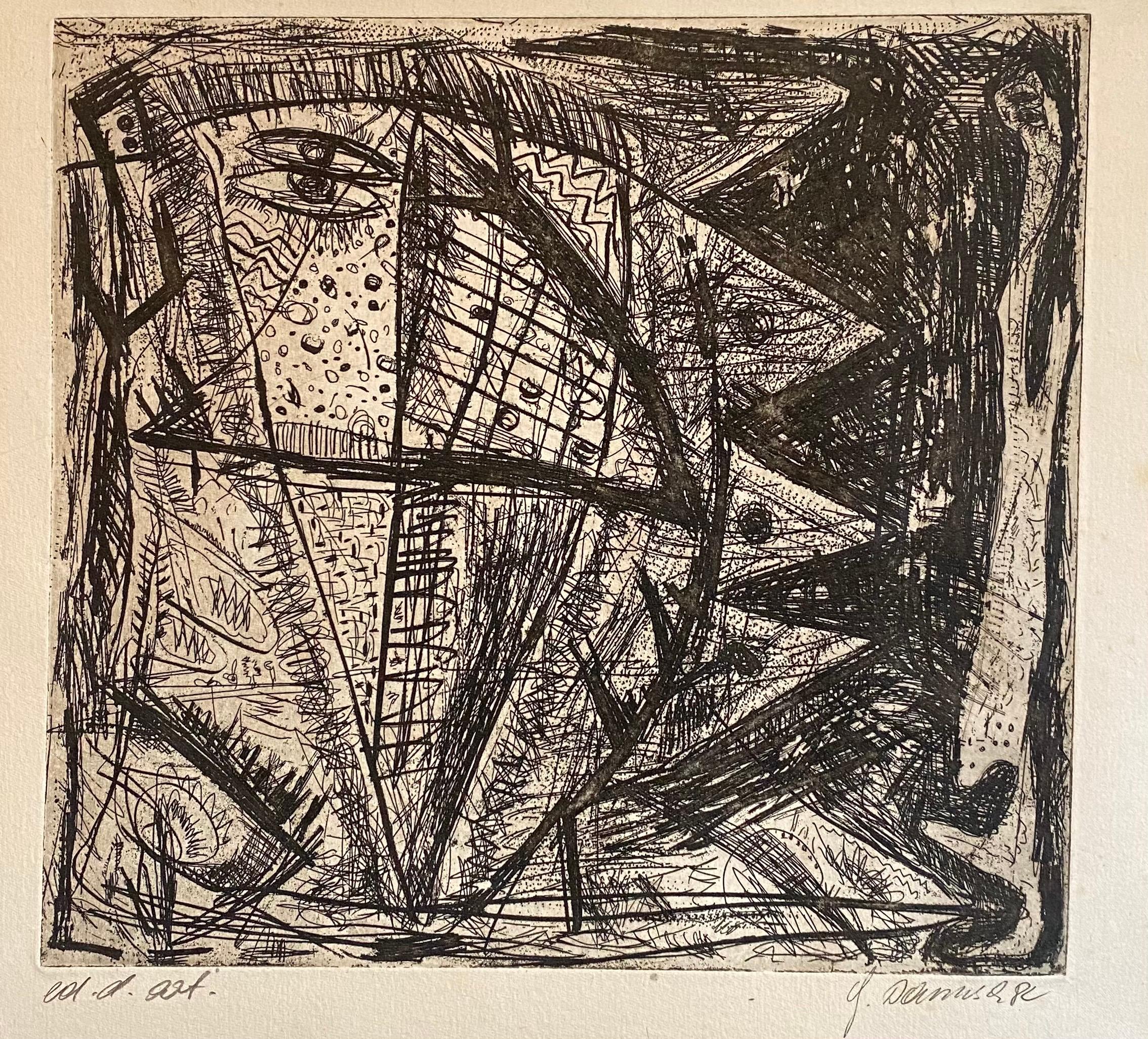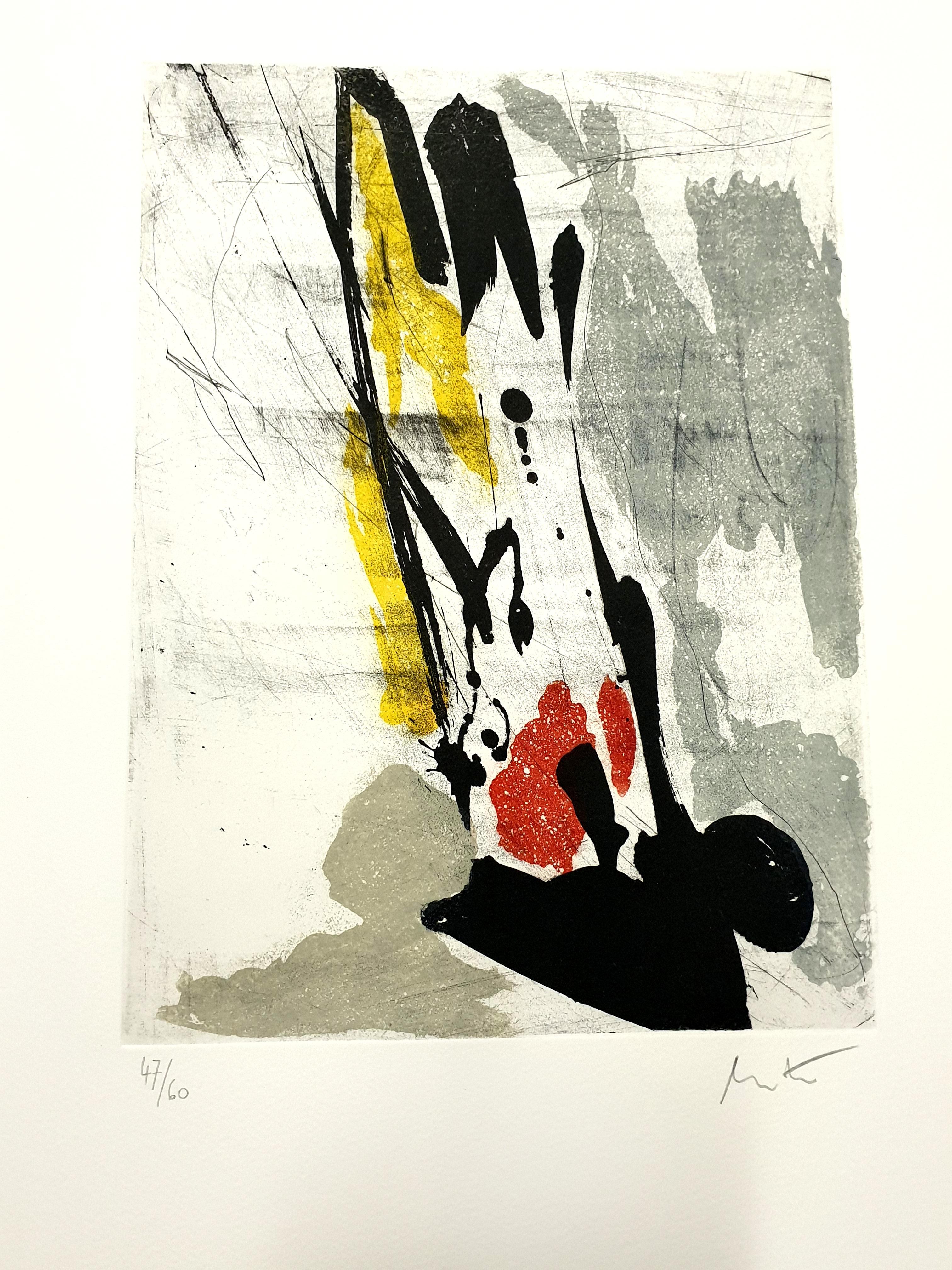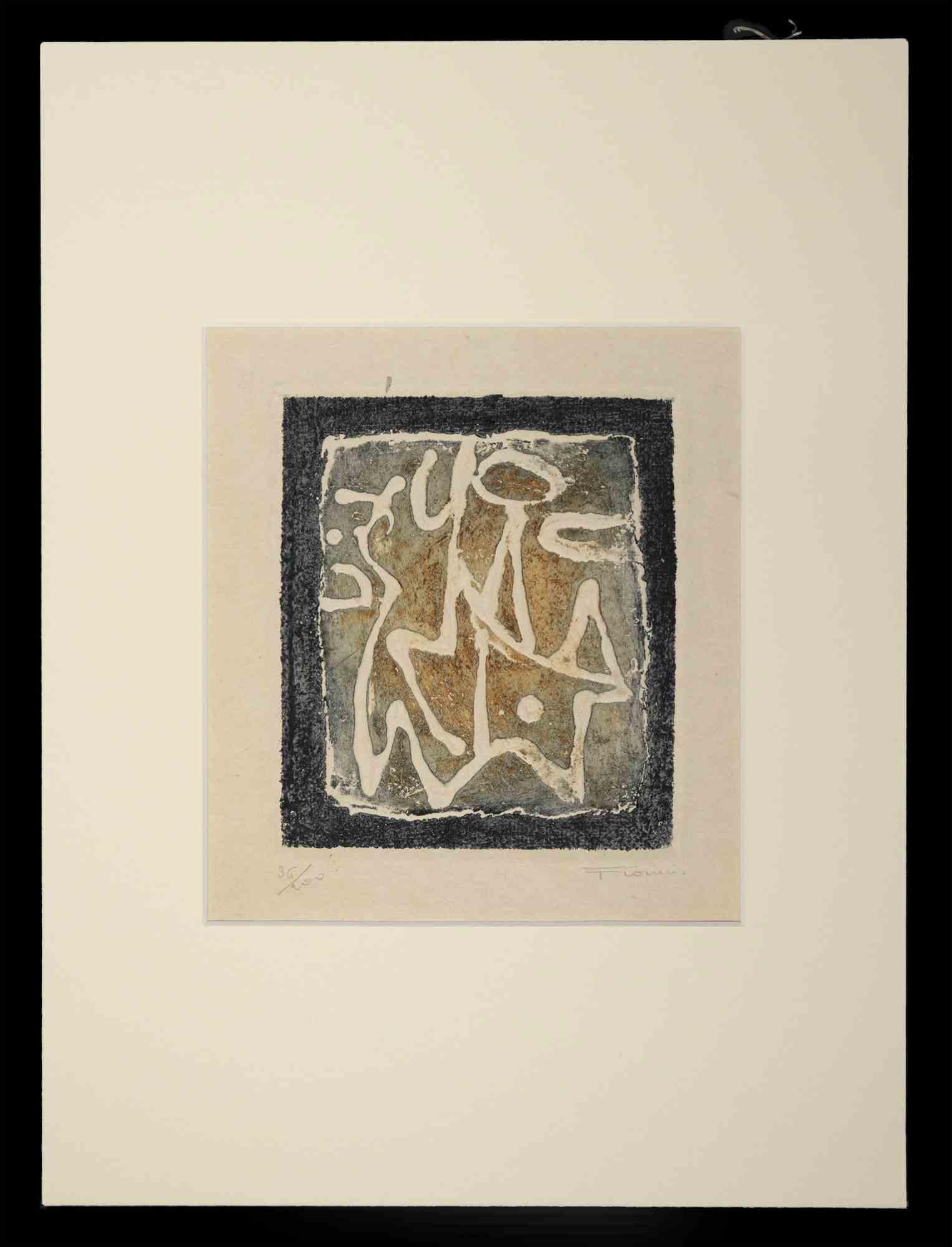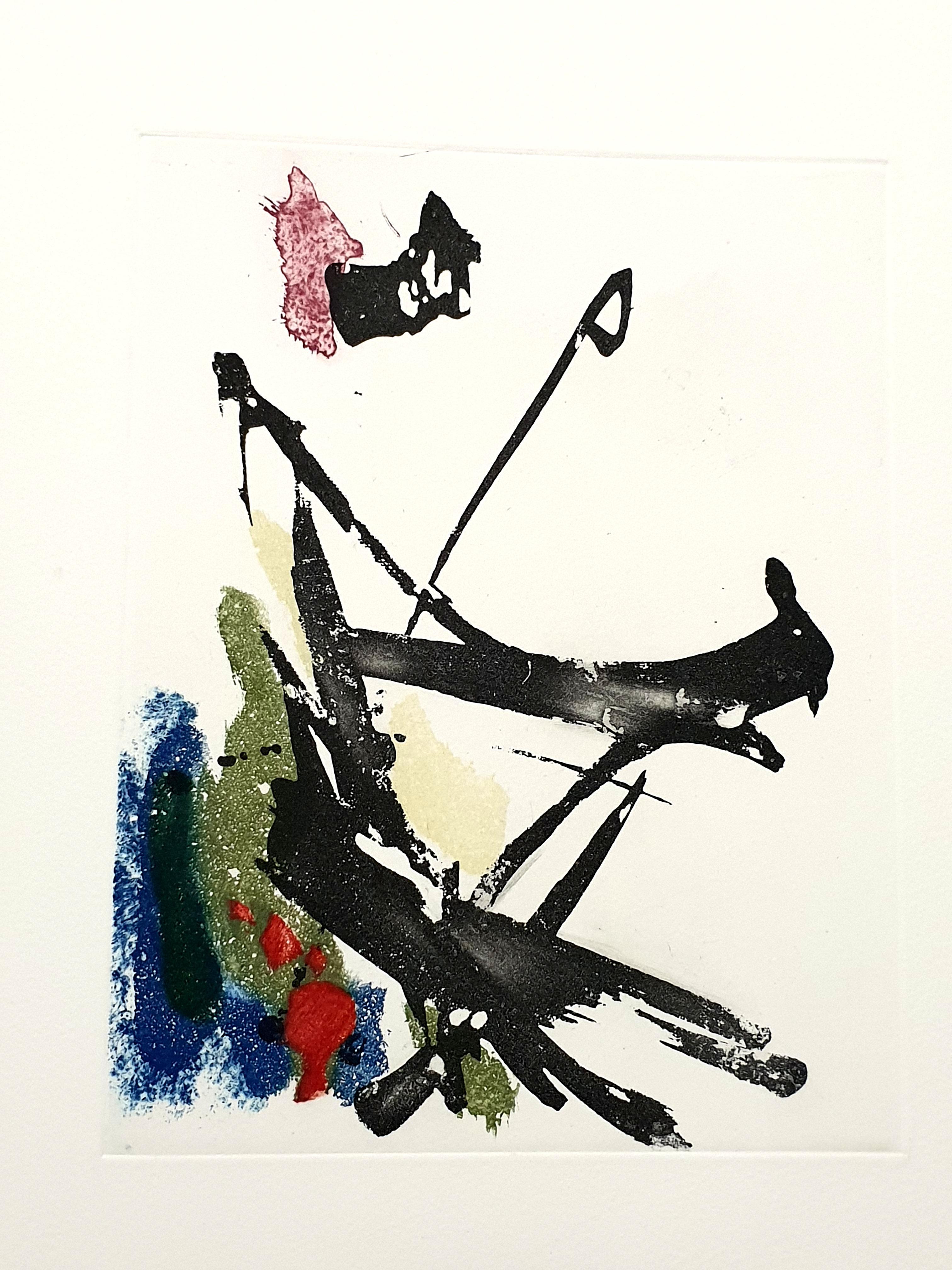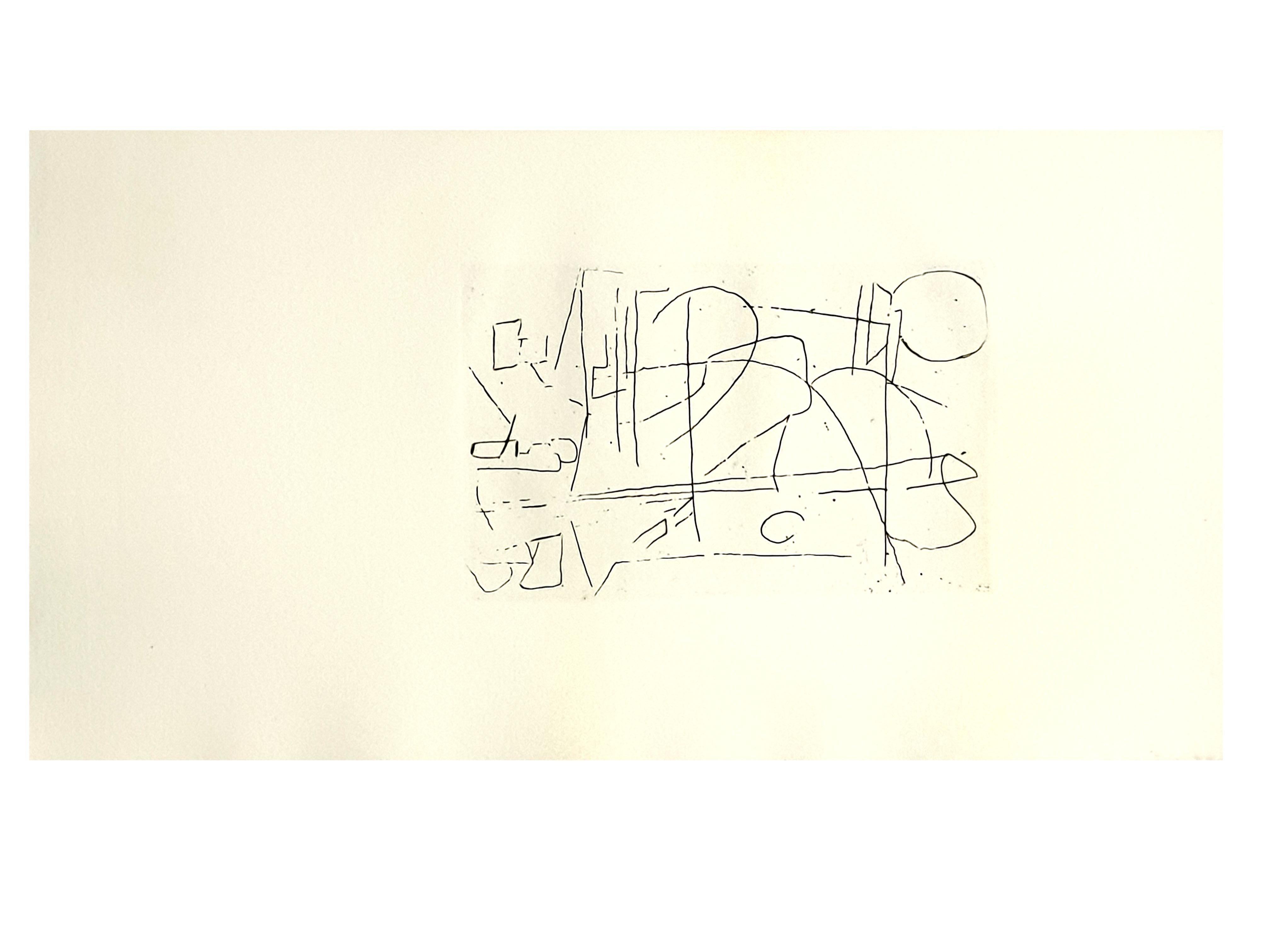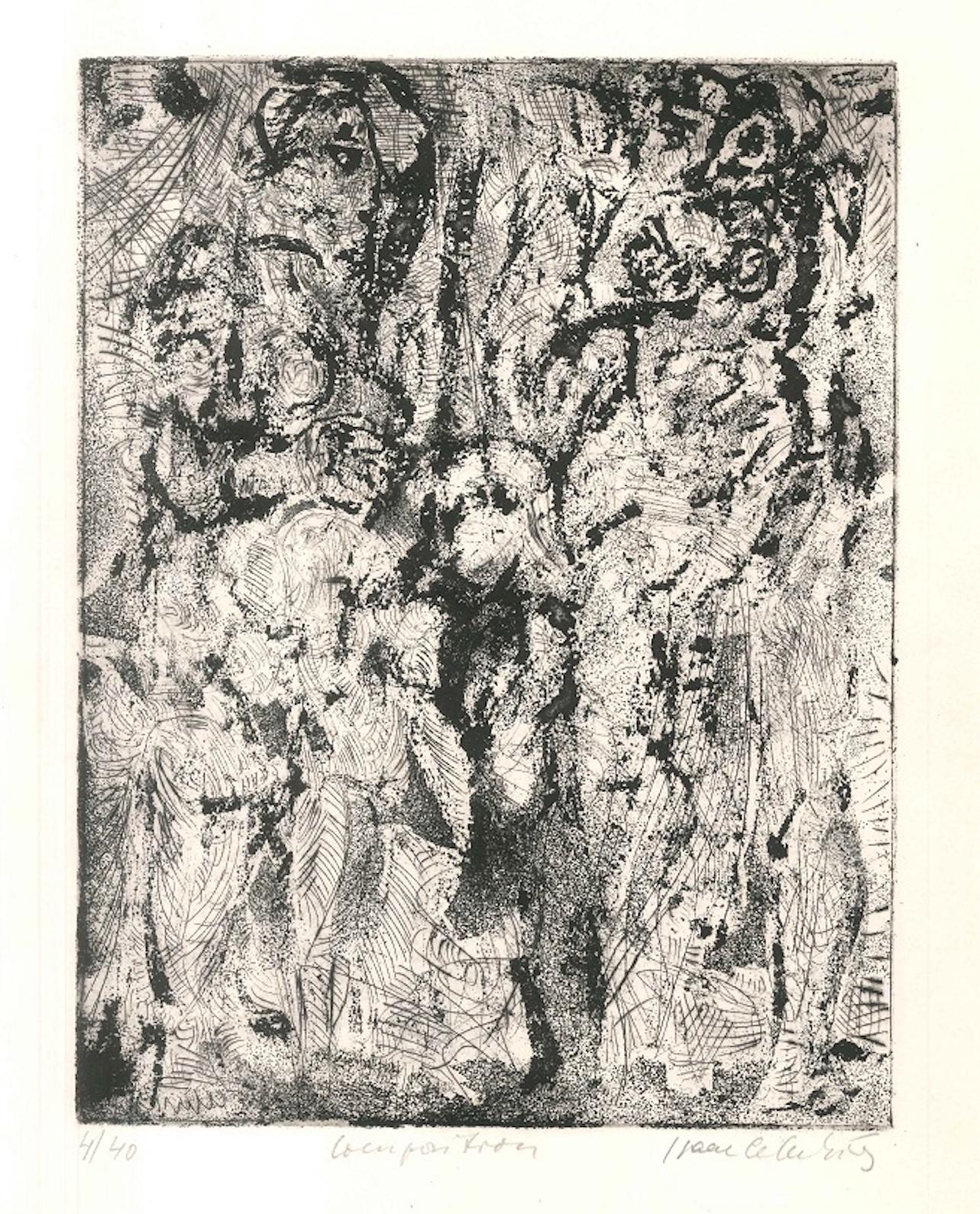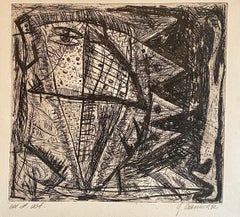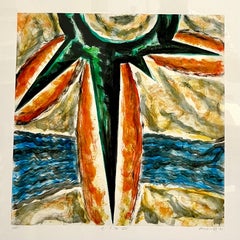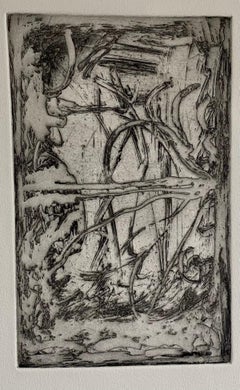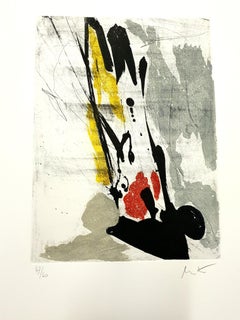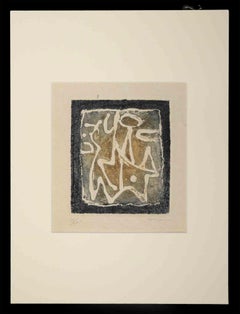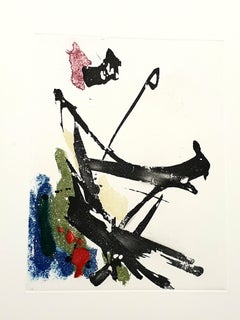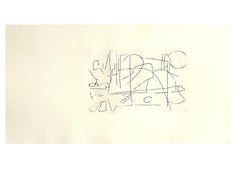Items Similar to Austrian Junge Wilde Abstract Etching Hand Signed, New Expressionist
Want more images or videos?
Request additional images or videos from the seller
1 of 10
Gunter DamischAustrian Junge Wilde Abstract Etching Hand Signed, New Expressionistc.1980s
c.1980s
$850
£660.96
€751.52
CA$1,224.61
A$1,338.95
CHF 700.02
MX$16,107.33
NOK 8,858.02
SEK 8,308.04
DKK 5,611.54
About the Item
Gunter Damisch (1958, Steyr- 2016 in Vienna) was an Austrian painter and sculptor . He is one of "den Neuen Wilde" New Savages. (Junge Wilde)
Gunter Damisch attended the Musikgymnasium Linz and then studied medicine and German and history for a few semesters. By age 16, he had already made 150 woodcuts and attended the International Summer Academy of Fine Arts in Salzburg with Claus Pack, he studied from 1978 to 1983 at the Academy of Fine Arts Vienna with Maximilian Melcher and Arnulf Rainer . In 1992 he took on a visiting professorship at the Vienna Academy (master class for graphics ) in Vienna, and since 1998 he has been a full professor there. From 1997 until his untimely death in 2016, he was head of the graphic arts department at the Vienna Academy of Fine Arts. the 1980s Damisch was a member of the Viennese punk band Molto Brutto, where he played bass and organ. Gunter Damisch lived and worked in Vienna and Freidegg . He was one of the most important international representatives of contemporary Austrian art because of his unmistakable, convincing and consistently formulated repertoire of colors and shapes (reminiscent of Friedensreich Hundertwasser.) He worked in stone lithos, woodcuts, lithograph, artists’ books like a free jazz virtuoso, making huge, one-of-a-kind pieces with collage, drawing, painting, woodcut and monotype on the same sheet. In 1978, the Junge Wilde painting style arose in the German-speaking world in opposition to established avant garde, minimal art and conceptual art. It was linked to the similar Transavanguardia movement in Italy, USA (neo-expressionism) and France (Figuration Libre). The Junge Wilde painted their expressive paintings in bright, intense colors and with quick, broad brushstrokes very much influenced by Professor at the Academy of Art in Berlin, Karl Horst Hödicke They were also known as the Neue Wilde. Artists included; Austria: Siegfried Anzinger, Erwin Bohatsch, Herbert Brandl, Gunter Damisch, Hubert Scheibl, Hubert Schmalix, G.L. Gabriel-Thieler
Germany: Berlin: Luciano Castelli, Rainer Fetting, Andreas Walther, Helmut Middendorf, Salomé, Bernd Zimmer, Elvira Bach, Peter Robert Keil Cologne: Hans Peter Adamski, Peter Bömmels, Jiri Georg Dokoupil, Volker Tannert, Stefan Szczesny, A. R. Penck. Düsseldorf: Jörg Immendorff, Albert Oehlen, Markus Oehlen, Martin Kippenberger, Markus Lüpertz, Werner Buettner, Horst Gläsker, Peter Angermann
Select Awards
1983 Römerquelle art competition
1985 Otto Mauer Prize , Max Weiler Prize
1991 Karl Rössing Prize
1995 City of Vienna Prize for Fine Arts
1996 Anton Faistauer Prize for Painting from the State of Salzburg
Prize at the 2nd International Graphic Triennial, Prague
1998 Culture Prize of the Province of Upper Austria for the fine arts
2011 Lower Austrian Culture Prize Appreciation Prize for Fine Arts
Select Public collections
Big World Hole Wall (1992), Linz, Museumstrasse 14 Germany
Art gallery in Emden , Emden, Austria
Essl Collection - Kunsthaus, Klosterneuburg
State gallery at the Upper Austrian State Museum , Linz
Lower Austrian State Museum , St. Pölten
Ploner Collection , Vienna
Angerlehner Museum , Thalheim near Wels
- Creator:Gunter Damisch (1958, Austrian)
- Creation Year:c.1980s
- Dimensions:Height: 16 in (40.64 cm)Width: 17.5 in (44.45 cm)
- Medium:
- Movement & Style:
- Period:
- Condition:minor wear in margins. please see photos.
- Gallery Location:Surfside, FL
- Reference Number:1stDibs: LU38215606402
About the Seller
4.9
Platinum Seller
Premium sellers with a 4.7+ rating and 24-hour response times
Established in 1995
1stDibs seller since 2014
1,826 sales on 1stDibs
Typical response time: 1 hour
- ShippingRetrieving quote...Shipping from: Surfside, FL
- Return Policy
Authenticity Guarantee
In the unlikely event there’s an issue with an item’s authenticity, contact us within 1 year for a full refund. DetailsMoney-Back Guarantee
If your item is not as described, is damaged in transit, or does not arrive, contact us within 7 days for a full refund. Details24-Hour Cancellation
You have a 24-hour grace period in which to reconsider your purchase, with no questions asked.Vetted Professional Sellers
Our world-class sellers must adhere to strict standards for service and quality, maintaining the integrity of our listings.Price-Match Guarantee
If you find that a seller listed the same item for a lower price elsewhere, we’ll match it.Trusted Global Delivery
Our best-in-class carrier network provides specialized shipping options worldwide, including custom delivery.More From This Seller
View AllAustrian Junge Wilde Abstract Etching Hand Signed, Neo Expressionist Art Print
By Gunter Damisch
Located in Surfside, FL
Gunter Damisch (1958, Steyr- 2016 in Vienna) was an Austrian painter and sculptor . He is one of "den Neuen Wilde" New Savages. (Junge Wilde)
Gunter Damisch attended the Musikgymnasium Linz and then studied medicine and German and history for a few semesters. By age 16, he had already made 150 woodcuts and attended the International Summer Academy of Fine Arts in Salzburg with Claus Pack, he studied from 1978 to 1983 at the Academy of Fine Arts Vienna with Maximilian Melcher and Arnulf Rainer . In 1992 he took on a visiting professorship at the Vienna Academy (master class for graphics ) in Vienna, and since 1998 he has been a full professor there. From 1997 until his untimely death in 2016, he was head of the graphic arts department at the Vienna Academy of Fine Arts. the 1980s Damisch was a member of the Viennese punk band Molto Brutto, where he played bass and organ. Gunter Damisch lived and worked in Vienna and Freidegg . He was one of the most important international representatives of contemporary Austrian art because of his unmistakable, convincing and consistently formulated repertoire of colors and shapes (reminiscent of Friedensreich Hundertwasser.) He worked in stone lithos, woodcuts, lithograph, artists’ books like a free jazz virtuoso, making huge, one-of-a-kind pieces with collage, drawing, painting, woodcut and monotype on the same sheet. In 1978, the Junge Wilde painting style arose in the German-speaking world in opposition to established avant garde, minimal art and conceptual art. It was linked to the similar Transavanguardia movement in Italy, USA (neo-expressionism) and France (Figuration Libre). The Junge Wilde painted their expressive paintings in bright, intense colors and with quick, broad brushstrokes very much influenced by Professor at the Academy of Art in Berlin, Karl Horst Hödicke They were also known as the Neue Wilde. Artists included; Austria: Siegfried Anzinger, Erwin Bohatsch, Herbert Brandl, Gunter Damisch, Hubert Scheibl...
Category
20th Century Contemporary Abstract Prints
Materials
Etching
Monoprint Lithograph American Modernist Gregory Amenoff Abstract Expressionist
By Gregory Amenoff
Located in Surfside, FL
Gregory Amenoff (Contemporary American abstract painter, b. 1948),
Monotype Monoprint (1990)
Hand signed in pencil lower right
plate: 16 x 16 inches
frame dimensions: 35 1/8 x 29 1/8 x 1 5/8 inches, wood frame with glazing
Provenance: Corporate Collection of Bank BNP Paribas
Gregory Amenoff is a painter who lives in New York City and Ulster County, New York. He is the recipient of numerous awards from organizations including the American Academy of Arts and Letters, National Endowment for the Arts, New York State Council on the Arts and the Tiffany Foundation. He has had over fifty one-person painting exhibitions in museums and galleries throughout the United States and Europe. His work is in the permanent collections of more than thirty museums, including the Whitney Museum of American Art, the Museum of Fine Arts in Boston, the Museum of Modern Art in New York and the Metropolitan Museum of Art. His work has the influence of both Abstract Expressionism and Pop Art in it, biomorphic forms in rich hues and thick textures with heightened colors and abstracted, organic forms, late American Modernism. He moved to New York in 1979, the artist rose to critical acclaim in the 1980s alongside Terry Winters, Bill Jensen, and Katherine Porter. The artist lives and works between New York, NY and his Hudson Valley residence.
He was a collaborating artist illustrating Bradford Morrow, Bestiary along with Joe Andoe, James Brown, Vija Celmins, Louisa Chase, Eric Fischl, Jan Hashey, Michael Hurson, Mel Kendrick, James Nares, Ellen Phelan, Joel Shapiro,
Kiki Smith, David Storey, Michelle Stuart, Richard Tuttle, Trevor Winkfield, Robin Winters. Linoleum cuts with
pochoir and woodcuts for the Grenfell Press, New York. Amenoff served as President of the National Academy of Design from 2001-2005. He is a founding board member of the CUE Art Foundation in New York City and serves as the CUE Art Foundation's Curator Governor. Amenoff has taught at Columbia for the last eighteen years, where he holds the Eve and Herman Gelman Chair of Visual Arts and is currently the Chair of the Visual Arts Division in the School of the Arts. He is currently the Vice-President of the National Academy.
In 2011 he received the John Solomon Guggenheim Fellowship.
Museum Collections
Albright-Knox Art Gallery; Buffalo, NY
Art Institute of Chicago; IL
Baltimore Museum of Art;
Brooklyn Museum of Art; Brooklyn, NY
Butler Institute of American Art; Youngstown, OH
Cleveland Museum of Art; Cleveland, OH
Currier Gallery of Art; Manchester, NH
Frances and Sidney Lewis Foundation; Richmond, VA
Hood Museum of Art; Hanover, NH
Honolulu Academy of Art; Honolulu, HW
Kemper Museum of Contemporary Art; Kansas City, MO
Maier Museum of Art; Lynchburg, VA
Metropolitan Museum of Art; New York, NY
Milwaukee Museum of Art; Milwaukee, WI
Minneapolis Institute of Art; MN
Muscarelle Museum of Art, College of William and Mary; Williamsburg, VA
Museum of Fine Arts; Boston, MA
Museum of Modern Art; New York, NY
National Museum of American Art; Washington, DC
Neuberger Museum, State University of New York at Purchase; NY
New York Public Library, Spencer Collection...
Category
1980s American Modern Abstract Prints
Materials
Lithograph, Monoprint, Monotype
American Abstract Expressionist Artist Melissa Meyer Aquatint Etching
By Melissa Meyer
Located in Surfside, FL
Melissa Meyer (American, b. 1946)
1984-1987, aquatint etching in black on wove paper, hand signed print, dated, and numbered from small edition of 10.
Unframed. size: 9.75'' x 6'', 2...
Category
1980s Abstract Expressionist Prints and Multiples
Materials
Etching, Aquatint
American Abstract Expressionist Artist Melissa Meyer Aquatint Etching
By Melissa Meyer
Located in Surfside, FL
Melissa Meyer (American, b. 1946)
1984-1987, aquatint etching in black on wove paper, hand signed print, dated, and numbered from small edition of 10.
Unframed. size: 9.75'' x 6'', 2...
Category
1980s Abstract Expressionist Prints and Multiples
Materials
Monoprint
Black/White Lithograph American Modernist Gregory Amenoff Abstract Expressionist
By Gregory Amenoff
Located in Surfside, FL
Gregory Amenoff (Contemporary American abstract painter, b. 1948),
Title: Haven, STATE II
Lithograph, 1986
Edition 4/4 Printer Proof
Image Size 21.5 x 30.75"
Gregory Amenoff is a painter who lives in New York City and Ulster County, New York. He is the recipient of numerous awards from organizations including the American Academy of Arts and Letters, National Endowment for the Arts, New York State Council on the Arts and the Tiffany Foundation. He has had over fifty one-person exhibitions in museums and galleries throughout the United States and Europe. His work is in the permanent collections of more than thirty museums, including the Whitney Museum of American Art, the Museum of Fine Arts in Boston, the Museum of Modern Art in New York and the Metropolitan Museum of Art. His work has the influence of both Abstract Expressionism and Pop Art in it, biomorphic forms in rich hues and thick textures with heightened colors and abstracted, organic forms, late American Modernism. He moved to New York in 1979, the artist rose to critical acclaim in the 1980s alongside Terry Winters, Bill Jensen, and Katherine Porter. The artist lives and works between New York, NY and his Hudson Valley residence.
Amenoff served as President of the National Academy of Design from 2001-2005. He is a founding board member of the CUE Art Foundation in New York City and serves as the CUE Art Foundation's Curator Governor. Amenoff has taught at Columbia for the last eighteen years, where he holds the Eve and Herman Gelman Chair of Visual Arts and is currently the Chair of the Visual Arts Division in the School of the Arts. He is currently the Vice-President of the National Academy.
In 2011 he received the John Solomon Guggenheim Fellowship.
Museum Collections
Albright-Knox Art Gallery; Buffalo, NY
Art Institute of Chicago; IL
Baltimore Museum of Art;
Brooklyn Museum of Art; Brooklyn, NY
Butler Institute of American Art; Youngstown, OH
Cleveland Museum of Art; Cleveland, OH
Currier Gallery of Art; Manchester, NH
Frances and Sidney Lewis Foundation; Richmond, VA
Hood Museum of Art; Hanover, NH
Honolulu Academy of Art; Honolulu, HW
Kemper Museum of Contemporary Art; Kansas City, MO
Maier Museum of Art; Lynchburg, VA
Metropolitan Museum of Art; New York, NY
Milwaukee Museum of Art; Milwaukee, WI
Minneapolis Institute of Art; MN
Muscarelle Museum of Art, College of William and Mary; Williamsburg, VA
Museum of Fine Arts; Boston, MA
Museum of Modern Art; New York, NY
National Museum of American Art; Washington, DC
Neuberger Museum, State University of New York at Purchase; NY
New York Public Library, Spencer Collection...
Category
1980s American Modern Abstract Prints
Materials
Lithograph
Pietro Consagra Italian Mod Abstract Expressionist Forma Brutalist Lithograph
By Pietro Consagra
Located in Surfside, FL
Pietro Consagra (Italian, 1920-2005).
Hand signed in pencil and numbered limited edition color lithograph on Magnani paper.
Embossed stamp with limited edition numbers in pencil to lower left, and having artist pencil signature to lower right.
(from a limited edition of 80 with 15 artist's proofs)
Published by Stamperia 2RC, Rome Italy and Marlborough Gallery, Rome, Italy.
Abstract Modernist work in colors, produced in the style of the Forma art movement of Postwar Italy, of which the artist was a prominent member.
Pietro Consagra (1920 – 2005) was an Italian Post war artist working in painting, printmaking and sculpture. In 1947 he was among the founding members of the Forma 1 group of artists, proponents of structured abstraction.
Consagra was born on 6 October 1920 in Mazara del Vallo, in the province of Trapani in south-western Sicily, to Luigi Consagra and Maria Lentini. From 1931 he enrolled in a trade school for sailors, studying first to become a mechanic, and later to become a captain. In 1938 he moved to Palermo, where he enrolled in the liceo artistico; despite an attack of tuberculosis, he graduated in 1941, and in the same year signed up at the Accademia di Belle Arti, where he studied sculpture under Archimede Campini. After the Invasion of Sicily and the Allied occupation of Palermo in 1943, Consagra found work as a caricaturist for the American Red Cross club of the city; he also joined the Italian Communist Party. Early in 1944, armed with a letter of introduction from an American officer, he travelled to Rome. There he came into contact with the Sicilian artist Concetto Maugeri, and through him with Renato Guttuso, who was also Sicilian and who introduced him to the intellectual life of the city and to other postwar artists such as Leoncillo Leonardi, Mario Mafai and Giulio Turcato. Consagra signed up at the Accademia di Belle Arti di Roma in September 1944 and studied sculpture there under Michele Guerrisi, but left before completing his diploma.
In 1947, with Carla Accardi, Ugo Attardi, Piero Dorazio, Mino Guerrini, Achille Perilli, Antonio Sanfilippo and Giulio Turcato, Consagra started the artist's group Forma 1, which advocated both Marxism and structured abstraction.
Steadily Consagra's work began to find an audience. Working primarily in metal, and later in marble and wood, his thin, roughly carved reliefs, began to be collected by Peggy Guggenheim and other important patrons of the arts. He showed at the Venice Biennale eleven times between 1950 and 1993, and in 1960 won the sculpture prize at the exhibition. During the 1960s he was associated with the Continuità group, an offshoot of Forma I, and in 1967 taught at the School of Arts in Minneapolis. Large commissions allowed him to begin working on a more monumental scale, and works of his were installed in the courtyard of the Foreign Ministry in Rome and in the European Parliament, Strasbourg. His work is found in the collections of The Tate Gallery, London, in Museo Cantonale d'Arte of Lugano and the Museum of Modern Art, Paris, and the National Gallery of Art in Washington, D.C..
Consagra returned to Sicily where he sculpted a number of significant works during the 1980s. With Senator Ludovico Corrao, he helped created an open-air museum in the new town of Gibellina, after the older town had been destroyed in the earthquake of 1968. Consagra designed the gates to the town's entrance, the building named "Meeting" and the gates to the cemetery, where he was later buried.
In 1952 Consagra published La necessità della scultura ("the need for sculpture"), a response to the essay La scultura lingua morta ("sculpture, a dead language"), published in 1945 by Arturo Martini. Other works include L'agguato c'è ("the snare exists", 1960), and La città frontale ("the frontal city", 1969). His autobiography, Vita Mia, was published by Feltrinelli in 1980. In 1989 a substantial retrospective exhibition of work by Consagra was shown at the Galleria Nazionale d'Arte Moderna in Rome; in 1993 a permanent exhibition of his work was installed there. In 1991 his work was shown in the Hermitage Museum in St. Petersburg. In 2002 the Galerie der Stadt Stuttgart opened a permanent exhibition of his work. He was one of ten artists invited by Giovanni Carandente, along with David Smith, Alexander Calder, Arnaldo Pomodoro, Lynn Chadwick, and Beverly Pepper, to fabricate works in Italsider factories in Italy for an outdoor exhibition, "Sculture nella città", held in Spoleto during the summer of 1962. He was included in the The 1962 International Prize for Sculpture the jury included Argan, Romero Brest and James Johnson Sweeney the former director of the Solomon R. Guggenheim Museum in New York. The participants included Louise Nevelson and John Chamberlain for the United States; Lygia Clark for Brazil; Pietro Consagra, Lucio Fontana, Nino Franchina, and Gió Pomodoro for Italy; Pablo Serrano for Spain; and Eduardo Paolozzi, William Turnbull, and Kenneth Armitage for England. Gyula Kosice, Noemí Gerstein, Julio Gero, Naum Knop...
Category
1960s Abstract Expressionist Abstract Prints
Materials
Lithograph
You May Also Like
Jean Miotte - Abstract Composition - Original Signed Etching
By Jean Miotte
Located in Collonge Bellerive, Geneve, CH
Jean Miotte - Original Signed Etching
1994
Dimensions: 41 x 33 cm
Signed and numbered in pencil
Edition: /60
From Près du mur
Category
1990s Abstract Expressionist Abstract Prints
Materials
Etching
Abstract Composition - Original Etching by Marcel Fiorini - Late 20th Century
By Marcel Fiorini
Located in Roma, IT
Abstract Composition is an original etching and aquatint realized in the 1960s Century by Marcel Fiorini (1922-2008).
Good Conditions. Edition of 36/100.
The artwork is depicted th...
Category
Late 20th Century Abstract Abstract Prints
Materials
Etching, Aquatint
Jean Miotte - Abstract Composition - Original Etching
By Jean Miotte
Located in Collonge Bellerive, Geneve, CH
Jean Miotte - Original Etching
1998
Dimensions: 41 x 33 cm
Edition: /40
From La Déchirure
Jean Miotte, 1926 - 2016
Miotte came of artistic age in the decade after World War II when non-figurative gestural abstraction was emerging on both sides of the Atlantic as the contemporary artistic language. The term, "L'Art Informel," was coined by the French critic, Michel Tapi, to connote "without form." The negation of traditional form, a radical break from established notions of order and composition, was particularly suited to a cultural environment born out of the circumstances of post war Europe where abuse of morals and fascist ideology had led to such horror and destruction.
While Informel is often regarded as the European equivalent of Abstract Expressionism, it is distinguished from its American counterpart, by a loss of faith in progress and the collective possibilities of an avant garde. Rather the artists who came to be grouped as Informel, Jean Miotte, Jean-Paul Riopelle, Emil Schumacher...
Category
1990s Abstract Expressionist Abstract Prints
Materials
Etching
André Lanskoy - Composition - Original Etching
By André Lanskoy
Located in Collonge Bellerive, Geneve, CH
André Lanskoy - Composition - Original Etching
From Dédale
Edition: 190
Dimensions: 32 x 18 cm
This etching is from the first series of etching Lanskoy made.
Unsigned and unumbered ...
Category
1960s Abstract Expressionist Abstract Prints
Materials
Etching
Composition - Etching by I. Celnikier - Late 20th Century
By Isaac Celnikier
Located in Roma, IT
Composition is a beautiful etching aquatint and drypoint on paper, realized by the artist Isaac Celnikier.
Titled, numbered and signed in pencil on the lower margin. Edition of 40 ...
Category
Late 20th Century Abstract Abstract Prints
Materials
Etching
André Lanskoy - Composition - Original Etching
By André Lanskoy
Located in Collonge Bellerive, Geneve, CH
André Lanskoy - Composition - Original Etching
From Dédale
Edition: 190
Dimensions: 32 x 18 cm
This etching is from the first series of etching Lanskoy made.
Unsigned and unumbered ...
Category
1960s Abstract Expressionist Abstract Prints
Materials
Etching
